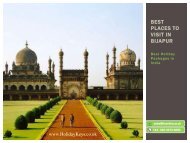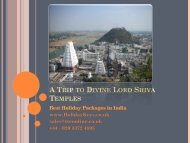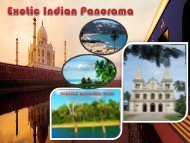Best Tourist Attraction Places in Gwalior - HolidayKeys.co.uk
Each and Every part of a country tells a story about its contribution to the country, whatever it is a small part or a big part, every member has its own importance in a family. India is also same; its every part has contributed to its history. “Gwalior” is one of them; it’s not a small city, now it’s a metropolitan city, and has its own historic background, located in Madhya Pradesh state, surrounded by rocky hills from all sides, on the north it has just formed the border of the Ganga–Yamuna Drainage Basin. The city is ruled by several historic northern kingdoms such as Maharaj Suraj Sen, the founder of the city, Naad dynasty of Pataliputra, Naga Dynasty, kushanas, Guptas, Kannauj of Gurar-Pratihara Dynasty, Kachwaha, Iltutmish, before Iltutmish Muhammad Ghori invaded the city and planned a mass destruction to capture the fort but unfortunately he failed by the brave efforts of Parihars. The rulers have remained their pages in history; they all contributed to in the history of the city through establishment some great structures. But the golden time was started from the Tomars Kingdom in 1375 by Raja Veer Singh; it was passed on to the Mughals, then to the Marathas in 1754 followed by the Scindias in the18th century.
Each and Every part of a country tells a story about its contribution to the country, whatever it is a small part or a big part, every member has its own importance in a family. India is also same; its every part has contributed to its history. “Gwalior” is one of them; it’s not a small city, now it’s a metropolitan city, and has its own historic background, located in Madhya Pradesh state, surrounded by rocky hills from all sides, on the north it has just formed the border of the Ganga–Yamuna Drainage Basin. The city is ruled by several historic northern kingdoms such as Maharaj Suraj Sen, the founder of the city, Naad dynasty of Pataliputra, Naga Dynasty, kushanas, Guptas, Kannauj of Gurar-Pratihara Dynasty, Kachwaha, Iltutmish, before Iltutmish Muhammad Ghori invaded the city and planned a mass destruction to capture the fort but unfortunately he failed by the brave efforts of Parihars. The rulers have remained their pages in history; they all contributed to in the history of the city through establishment some great structures. But the golden time was started from the Tomars Kingdom in 1375 by Raja Veer Singh; it was passed on to the Mughals, then to the Marathas in 1754 followed by the Scindias in the18th century.
You also want an ePaper? Increase the reach of your titles
YUMPU automatically turns print PDFs into web optimized ePapers that Google loves.
www.<strong>HolidayKeys</strong>.<strong>co</strong>.<strong>uk</strong><br />
The Teli Ka Mandir is a huge structure <strong>in</strong> the city, this make itself dist<strong>in</strong>guished from the other<br />
architectures, its about 100 feet, and it is <strong>co</strong>mpletely different <strong>in</strong> architecture, it is made <strong>in</strong><br />
Dravidian and North Indian style. It is a Lord Vishnu. The temple bears a close resemblance to the<br />
temple of Prathihara Vishnu, and is filled with images of <strong>co</strong>iled serpents, passionate <strong>co</strong>uples, river<br />
goddesses, and a fly<strong>in</strong>g Garuda. It is one of the major tourist attractions.<br />
Ja<strong>in</strong> rock-cut sculptures also rema<strong>in</strong>s there, a series of cave rock out sculptures, excavated <strong>in</strong> the<br />
rock on all sides, number<strong>in</strong>g about nearly hundred. They were all excavated with<strong>in</strong> a short period<br />
of about thirty-three years, between 1441 and 1474. One of the <strong>co</strong>lossal figures is 57 ft high,<br />
taller than any other <strong>in</strong> northern India. There are also Ja<strong>in</strong> temples <strong>in</strong> the fort, which has all the<br />
26 Thiranthkars of Ja<strong>in</strong>ism.<br />
The Jai Vilas Mahal was built <strong>in</strong> 1874, as the residence of the Marathas – the Sc<strong>in</strong>dias, now it is<br />
turned to the museum. It is a heart of the city. It has all the antique and unique <strong>co</strong>llections of<br />
gadgets and <strong>co</strong>llection that is impossible to see anywhere else. It is the largest museum <strong>in</strong><br />
Madhya Pradesh and worlds largest chandeliers and it is a mixture of British and H<strong>in</strong>du<br />
architecture.<br />
There is the burial place of the Sc<strong>in</strong>dias, who ruled the city, is situated near the Achaleshwar<br />
temple named as Chatris of Sc<strong>in</strong>dias. The designated persons like Maharaja Madhavrao Sc<strong>in</strong>dia,<br />
Vijayaraje Sc<strong>in</strong>dia and His Highness Jivajirao Sc<strong>in</strong>dia were cremated here.


















